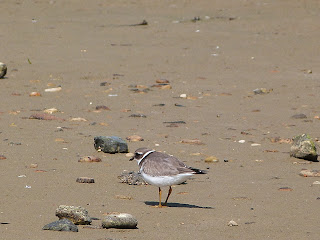Waders are tricky chaps to identify in general so it is a relief when one sees some, even from a long way off, and you know immediately what they are. The ringed plover (Charadrius hiaticula) is aptly named and, for once, the name gives the clue to identification. The ringed plover has two rings around its neck; not actual rings of course, but colouration rings. One is white and the other black and these rings stand out clearly, even at some distance. They are unlikely to be mistaken for any other bird provided, of course, you are not looking at a little ringed plover! Little ringed plover are, naturally, somewhat smaller than their cousins and tends to be more solitary. It is also less frequently seen.
Being a wader you will usually find ringed plover near sea water, often on exposed mudflats at low tide but they can also be found on shingle beaches where they like to explore the strand line for flies and grubs amongst the drying seaweed. The distribution map shows many of the sites around Poole harbour have recorded ringed plover as well as in Christchurch harbour and at various points along the Fleet. Ferrybridge and Lytchett Bay seem to be hot-spots for ringed plover with many of the records coming from these two sites.
In common with some other species the theory that they are winter visitors having bred in the Arctic is dispelled somewhat by the weekly observation chart. There are a small number of reports from the summer months whilst they should be 'up north' and records are few and far between in winter with a very low record count from November through until the end of March. This may be due to under recording of course but may also indicate that the ringed plover is more of a passage migrant than a winter visitor. There are definite peaks in recording between week 17 and 22 (May) in spring and between 30 and 40 (mid July to end of September) in the autumn when they are obviously on the move one way or the other.
Your best bet for ringed plover watching is to head to Ferrybridge in August or September where a good number can be seen on the mudflats behind the visitor centre at low tide.

Comments
Post a Comment